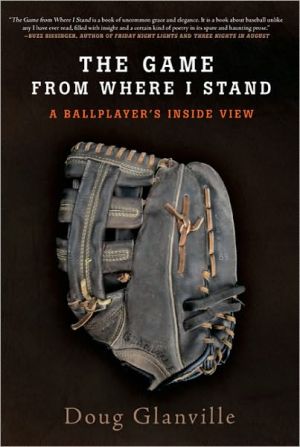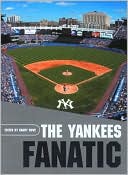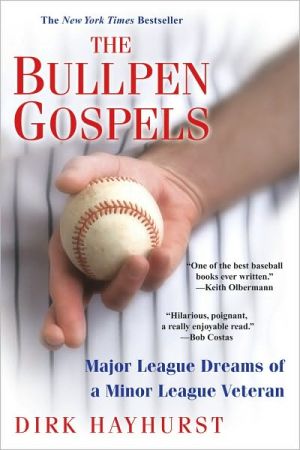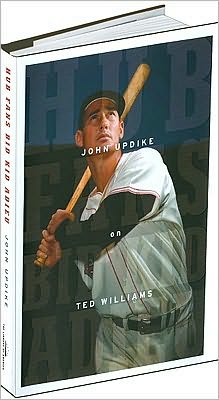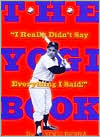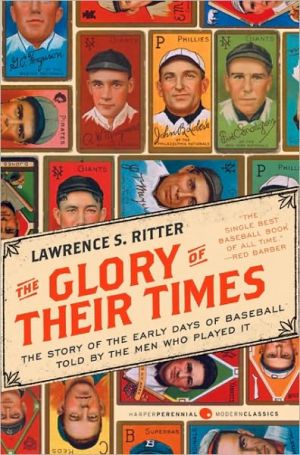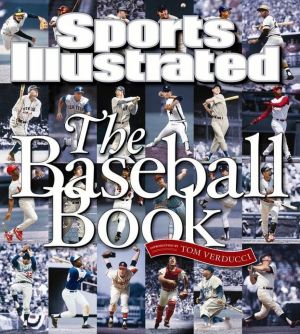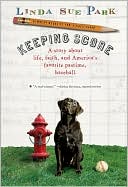The Game from Where I Stand: A Ballplayer's Inside View
An insider's revealing look at the hidden world of major league baseball\ Doug Glanville, a former major league outfielder and Ivy League graduate, draws on his nine seasons in the big leagues to reveal the human side of the game and of the men who play it.\ In The Game from Where I Stand, Glanville shows us how players prepare for games, deal with race and family issues, cope with streaks and slumps, respond to trades and injuries, and learn the joyful and painful lessons the game imparts....
Search in google:
An insider's revealing look at the hidden world of major league baseballDoug Glanville, a former major league outfielder and Ivy League graduate, draws on his nine seasons in the big leagues to reveal the human side of the game and of the men who play it. In The Game from Where I Stand, Glanville shows us how players prepare for games, deal with race and family issues, cope with streaks and slumps, respond to trades and injuries, and learn the joyful and painful lessons the game imparts. We see the flashpoints that cause misunderstandings and friction between players, and the imaginative ways they work to find common ground. And Glanville tells us with insight and humor what he learned from Jimmy Rollins, Alex Rodriguez, Randy Johnson, Barry Bonds, Curt Schilling, and other legendary and controversial stars.In his professional career, Glanville experienced every aspect of being a player—the first-round pick, the prospect, the disappointment, the can't-miss, the cornerstone, the veteran, the traded, the injured, the comeback kid. His eye-opening book gives fans a new level of understanding of day-to-day life in the big leagues. The Washington Post - Dave Sheinin If Jose Canseco's 2006 blockbuster, Juiced, with its tawdry depictions (and named names) of rampant steroids use and womanizing, was the template for the modern ballplayer memoir, Glanville's book is the polar opposite…Glanville…is a witty, insightful writer, and his detailed descriptions of the unseen banalities and secret vanities of the baseball life—how players pass the time during rain delays, the proper way to pack an equipment bag after you've been cut, the admission that players practice signing their autograph—are sometimes riveting and often amusing, even for those of us already intimately familiar with that life.
The Game from Where I Stand\ A Ballplayer's Inside View \ \ By Glanville, Doug \ Times Books\ Copyright © 2010 Glanville, Doug\ All right reserved.\ ISBN: 9780805091595 \ \ \ INTRODUCTION\ "Now batting, the center fielder, number six, Doug Glanville."\ For fifteen professional seasons, nine of them in the major leagues, those words (or some variation of them) began my workday. I heard them in tiny smalltown ballparks and in tripledecker urban stadiums that seated fifty thousand people or more. I heard them in spring training; I heard them in the playoffs; I may have even heard them in my sleep. The sound never got old.\ I was a center fielder, and once I got a taste of what that meant, I never wanted to play any other position. There is no other place on the field with such uninhibited sight lines to take in all that baseball has to offer. My job as the center fielder was to run down everything hit in my direction, but it was also to lead, to make sure my fellow outfielders knew where to play before the ball was hit.\ There is an immense beauty in standing in the center of the outfield and being able to see everything. From center field you can see where the catcher is setting up and, based on your knowledge of your team's pitching staff, know to a high degree of accuracy what is about to happen. You can watch a pickoff play about to develop and anticipate that the base runner is about to erase a potential run by being too jumpy. You can even see what is happening in the stands and note that your dad just got back to his seat after buying a big bag of popcorn.\ A center fielder has to fully understand where the other players are relative to one another before every pitch. If I had a speedy right fielder playing alongside me, I could feel confident giving him more room. I had to know the abilities and range of everyone on the field to maximize our chance to record an out on any given play. If I was too close, I cut down our range as a team; if I was too far away, balls fell in safely. I had to be able to look at my teammates and keep our spacing constant, accounting for the count, the wind, the speed of my fellow outfielders, even my sore hamstring.\ These calculations became second nature to me, because unlike most ballplayers, I am an engineer by training. When I was draft ed by the Chicago Cubs in the first round of the 1991 amateur draft, I was a junior at the University of Pennsylvania, studying systems engineering. Not that many Ivy League student athletes are scouted by the pros, but the Cubs must have seen something they liked, because they picked me twelfth overall, one slot ahead of a high school phenom from New York City named Manny Ramirez. (Hmmm, wonder what ever happened to him.)\ Once I signed on the dotted line accepting the Cubs' signing bonus offer, dream met reality and I began my journey to the big leagues.\ As a firstround draft pick, all eyes are on you and there is no other place to be but center stage. In July 1991, I reported to the Geneva Cubs, who played in a college town in upstate New York. I lived on Main Street and remember hearing the light change from green to yellow to red. My rite of passage began.\ In 1992, I made a stop in the Carolina League in WinstonSalem, complete with three roommates. We seemed to have a revolving door out front since every other day one of us was affected by a frontoffice move. Released, demoted, promoted.\ After the season, the frontoffice executives who had draft ed me were fired, and the new regime sent me back to the same level in 1993 with a promise of advancement midseason. True to their word, I was promoted to the DoubleA Orlando Cubs. Welcome to the world of Disney.\ I would play in Orlando for two seasons, and my oncepromising career seemed to be stuck in neutral. But in the fall of 1994, I received an invitation to play in the Arizona Fall League. It was here where it all started to come together. A playeroftheweek award gave me optimism that I was seeing progress. I was performing well against the best the minor leagues had to offer.\ When the final tallies were counted, my performance in the fall league solidified a spot for me on the Cubs' TripleA team in Des Moines, Iowa. I did not know it at the time, but it was here that I would face an unexpected test. The manager of the Iowa Cubs, Ron Clark, and I did not get along. Our differences had begun the year before, when I was in Orlando. Clark was the minor league director of instruction at the time, and after one game he called me into the office to discuss a baserunning decision I had made. Clark told me that I had made the wrong choice. I disagreed, but we didn't agree to disagree; we just fought for the last word. He would file this act of insubordination away.\ In Iowa, every day was a battle. It was a year of constant badgering and a lot of tentative mistakes on the field, but one of the things that kept me going was the encouragement of our hitting coach, Glenn Adams. Keep working, keep your head up, he told me.\ At season's end, my numbers were unimpressive. By now, I was twentyfive years old, which is ancient for a minor leaguer, and the Cubs asked me to play in the Instructional League that fall, an opportunity typically reserved for much younger players and a sign that my future had to be now. Fortunately, I met Tom Gamboa, a manager who would take me to Puerto Rico to play for his Mayaguez Indios in winter ball. It was there that I found my stride, winning an MVP trophy and, the next year, a championship.\ To play so well after being buried in TripleA was striking, even to the Cubs' front office. What was in the water in Puerto Rico? Part of the problem was that my TripleA manager never took the time to know my story.\ That story was one of determination. I chose to complete my college education after I was drafted, to fulfill a promise to my family. I had taken a leave of absence during the spring semester of my senior year to play for WinstonSalem, but when the fall came, it was my time to finish what I started and graduate.\ My parents had set the tone for education. Growing up as the son of a math teacher and a practicing psychiatrist gave me a strong academic base.\ My mom, who hailed from Rocky Mount, North Carolina, was the oldest of four children and a born teacher. She followed this knack for leadership right through the public school system in my hometown of Teaneck, New Jersey, where she taught for over twenty years. She thrust herself directly into Teaneck's commitment to introduce diverse groups of people to one another by organizing cottage parties and by participating in crosscultural social events like "Friendship Day." She had the strength common to the most uncommon teachers: a sense for making her audience know that she was talking to each person individually.\ My father left his homeland of Trinidad and Tobago at the age of thirtyone in the midst of a political shakeup in the school system, where he had served as an assistant headmaster. His journey would take him to Howard University in Washington, D.C., where he would attend medical school. His skill in critical thinking helped shape the way I evaluated situations and people. His vast array of responses to scenarios and his unwavering ability to disarm anyone with one cool phrase were transformational for me. Through genuine humility, he brought everyone into a common space.\ He was also a true Renaissance man. His primary passion was writing poetry, and after his passing he left a collection of poems for everyone to continue to learn from and find joy in.\ But it was my brother who was all about baseball. He laid out a plan for my baseball destiny by listing the steps to major league glory. He is still playing baseball today, at the age of fortyseven; he is the one member of our family who has always passionately followed his heart, whatever the expense.\ My parents had many choices of where to build their life, but they chose Teaneck, a blossoming beacon of diversity in the homogeneous, wealthy suburbs of Bergen County.\ No place shaped my perspective as much as Teaneck. In the 1960s Teaneck had been at the forefront of integration, bringing black and white students together to learn in the same space, setting the expectation that diversity would be embraced. Diplomacy became a huge part of my worldview as I witnessed people of all walks learning how to communicate with one another.\ It was also this experience that made the major leagues feel like home once I got my first callup to the Cubs on June 9, 1996. I was sent down once, but by September I would be back up for what would be the remainder of my career.\ But I would not stay with the Cubs for long. They traded me on December 23, 1997, to the Philadelphia Phillies, which opened up my career. I would be going back to the East Coast, playing for my childhood favorite team, going back to my college town, and—best of all—starting. (Yes, the Phillies were my favorite team growing up. You would think that a northern New Jersey kid would love either the Mets or the Yankees, but my brother got me into sports so young that I chose my favorite team simply by the color of their uniform. Nothing could beat those powder blue road uniforms of the Phillies in the 1970s.)\ My five seasons in Philadelphia embodied the complete major league experience. I came as the rising prospect, wise in years but still with much to prove. I left as the disgruntled and exhausted role player, whose role was mostly to teach my replacement how to play the game.\ In between, I experienced all it is to be a major leaguer. I have been the disappointment, I have been the "can't miss," I have been the cornerstone, I have been the underpaid, I have been the overpaid, I have been the marginalized veteran, I have been the "lost a step," I have been the "traded for," I have been the daytoday, I have been the comeback kid, I have been the free agent, but most of all, I have been a fan, friend, son, little brother, and hometown hero. There were good years and bad years, I was a hero and a goat, but through it all I was only human.\ My life was turned upside down in 2000, when I received news on the last day of spring training that my father had suffered the first of a series of strokes. With a season about to start, I had no idea what to do. I played on, but with a heavy heart.\ In August 2002, after many anxious times, things took a turn for the worse. With an already deadly cocktail of strokes, a lung cancer diagnosis, a previous heart attack, and diabetes, my father experienced yet another major stroke. When my mother spoke to me on the phone that morning, she was trying to stabilize him in the Hackensack Medical Center emergency room. She later told me that after my father had been declared "nonresponsive," he had recovered consciousness when, during her conversation with me, she said the word baseball. So, to me, his condition had gone from grave to horrible—and that was progress. I was optimistic. I sensed he would still be with us when I got there.\ I drove up from Philadelphia, essentially on autopilot the whole way. My dad was semicomatose when I entered his hospital room, but he straightened up and smiled—and then went back into his coma. The doctor, a close family friend, spat out unrecognizable (to us) figures to explain my father's state that, when translated into layman's terms, basically told us that he was on borrowed time. Yet my father defiantly showed us that numbers were only for the emotionally conservative.\ I hugged my mother, and I told her that I had to get back to the team. On the drive back to Philadelphia, I felt a renewed strength. I turned up the radio and cruised down the highway. Something told me that my father would be in my life for a little while longer. The numbers hadn't suggested that, but his spirit did. The music reached a crescendo, and I unwittingly blew past the speed limit. Sirens blared, and as I slowly pulled over, I thought, I have a pretty good excuse. But I didn't have time to give it. The officer, a Phillies fan at heart, recognized me and—as he wrote me up—started telling me, "You're having a tough year, but numbers are not important; your value to our community is priceless."\ I never had been so thankful to receive a speeding ticket. It was a small price to pay for having someone remind me of what amazing blessings and gifts I'd had in my life. I had so much to smile about. After all, my father was still smiling.\ From that point on, I proceeded to play the best baseball I had played in years. My paltry .200 batting average rose nearly fifty points, and by season's end I was two hits away from my 1,000th career hit. I sensed that I was going to be fine. When I arrived at Pro Player Stadium in Miami for the last game of the season, my name was penciled in atop the batting order. I wasted no time. I got a hit in my first atbat for number 999, and in my next turn, I smoked a single into left for my 1,000th. I felt unstoppable that day, as if something bigger than me was swinging the bat on my behalf.\ At 7:15 p.m., it was over; the Phillies had fallen short, but I had collected not only my 1,000th hit but my 1,001st as well. At that precise moment, my father passed away.\ Maybe his work was done here; maybe he felt that peace within that all men long for but are afraid to court. Somehow, deep down, I knew it was a good thing. I also knew that he gave me the confidence and faith that when my turn came, I would embrace it, too.\ I would leave Philadelphia that winter, signing as a free agent with the Texas Rangers. I thought it would be a new start, but I tore a hamstring in April, spent six weeks on the disabled list, and in late July, I found myself traded back to my first team, the Chicago Cubs. Though I was no longer a starter, the Cubs did give me an opportunity to play in the postseason that fall, and even though it ended badly (as it so often seems to for the Cubs), it was still an unforgettable experience.\ I returned to the Phillies for the 2004 season, but I was now firmly entrenched as a bench player, which was not where I wanted to be. I figured that if I was going to be a reserve, I might as well play for a team with a chance to win a championship. So in February 2005 I reported to spring training with the New York Yankees, hoping to win a reserve outfield spot.\ The Yankees ran me out there every day during the exhibition games. To combat any wearing down, I was in the gym at least twice a day working on my body.\ I was playing fairly well, not lighting the world on fire, but steady. My competition for the last slot, Bubba Crosby, was battling leg problems, and I thought I might get a few points for staying healthy. But Crosby soon regained his health and came back on fire—as I cooled off .\ A week before Opening Day, we played the Phillies at their camp, and just as my career had begun with a base hit to left off the Phillies' Terry Mulholland at Veterans Stadium, on this day I smacked a base hit to left off the Phillies' Tim Worrell. After the game, the Yankees' general manager, Brian Cashman, and manager, Joe Torre, brought me into the office to tell me that I had been released. They were giving me a week's head start to catch on with another team. I didn't say much other than to thank them for the opportunity. I thought I was a good fit for the Yankees: a player who had been a starter, able to play all fields, and young enough to run out there a lot. But I was trumped.\ I would no longer take my place in center field, at least not as a major leaguer, although I still believed I belonged there. Not because I was bitter about my rejection, but because the spirit of what makes center field so special is within me.\ It was where I could make the best use of my skills, which is what my parents expected most from me. A center fielder is at once a player, a strategist, an observer, and a thinker—good preparation for writing a book.\ This book is my attempt to open up the hidden world of baseball players, to reveal the human side of the game and the human side of the men who play it. There is a richness to the experience of playing baseball that is not visible to fans or commentators, and by sharing it with you, I hope to bring you a greater appreciation of what happens on the field and off, and to give you a taste of what it's like to sit in the dugout, to relax in the clubhouse, to stand in the ondeck circle, to run the bases, to position yourself in the outfield.\ The book is distilled from my observations, sentiments, assumptions, and reflections from standing at the heart of the diamond, to paint a complete picture of what a life in baseball is like. You'll meet the teammates, opponents, managers, coaches, girlfriends, buddies, and other people who populate a ballplayer's world, and you'll see the game from behind the scenes, a perspective that gets left out of most coverage of this sport. You'll get a better idea of what goes on inside a player's head as he digs in at the plate, stands ready in the field, or rides the bench. The stories I tell are every player's story and are testimonials to the human condition in all its glory and frailties, something not exclusive to baseball.\ In fact, if I have done this great game justice, you will find that whether or not you have ever picked up a bat or thrown a ball, this book could be your story as well.\ \ \ Continues... \ \ \ \ Excerpted from The Game from Where I Stand by Glanville, Doug Copyright © 2010 by Glanville, Doug. Excerpted by permission.\ All rights reserved. No part of this excerpt may be reproduced or reprinted without permission in writing from the publisher.\ Excerpts are provided by Dial-A-Book Inc. solely for the personal use of visitors to this web site. \ \
Introduction xi 1. Before the First Game 12. Preparing for the Game 223. During the Game 364. Respecting the Game 615. The Stresses of the Game 816. Relationships in the Game 987. Bridging Differences in the Game 1258. Giants of the Game 1559. The Integrity of the Game 180 10. Toward the Last Game 202 11. Reflections on the Game 223Epilogue 247Appendix: In the Book 251Acknowledgments 259Index 265
\ From the Publisher\ “Doug Glanville was always different from other baseball players -- in a good way. . . . He was more like one of us (regular folks) than one of them (exalted athletes). He saw himself the way you would if you made the majors: full of self-awareness and humanity, traits that are otherwise in short supply in the VIP-treated, image-conscious world of pro sports. It stood to reason, then, that Glanville’s baseball memoir, The Game from Where I Stand, would be different as well. . . . [Glanville] is a witty, insightful writer. . . . Many times during the steroids scandal, it has seemed as if the players were on one side of the battle and the baseball writers were on the other. In Glanville, finally, we have someone who is of both camps, and everyone on either side would benefit from hearing what he has to say.”—The Washington Post “Doug Glanville is a salesman. The former Cub is selling two of the most vanishing commodities on the contemporary American slipscape -- empathetic insight and independent thought….It's an engaging and thoughtful detailing of the way a smart, feeling player processed and parried with the realities of megabyte-era Major League Baseball.”— Jim O’Donnell, Chicago Sun-Times “Glanville has an effective knack for unveiling the usually untold story of the tricky balancing act of real life -- ill family members, love life, confidence issues, lifestyle choices, injuries -- most players are constantly engaged in with varying degrees of success. . . . Generous, perceptive, wise (he’s a Penn graduate, after all) and thoughtful, Glanville further distinguishes his career with this rich and rewarding look back at it.”--Boston Herald “Like a player peering from dugout steps, surveying the field and the game, Glanville has a wonderful vantage.”—Cleveland Plain-Dealer “Filled with sharp insights, keen observations, and great stories, his book is championship caliber.”—The Philadelphia Inquirer “Doug Glanville . . . is as adept at thinking and writing about baseball as he was at playing it.”—Men’s Journal “The Game From Where I Stand. . . . is not just a riveting read; it’s also a thoughtful and articulate examination of the game and the sometimes-fragile humans who play it.”--The Pennsylvania Gazette “Glanville hits for the cycle with an elegantly written, up-close-and-personal, deliciously detailed, side-splitting and sad account of the day-to-day life of a journeyman ballplayer. . . . He reveals, as no one before has, what it's like to be a ‘boy of summer.’”—Tulsa World\ “The Game from Where I Stand is our must-read baseball book of 2010. . . . Glanville [offers] some of the most intelligent and insightful commentary on the game today.”--The Kansas City Star’s “Ball Star” blog \ “The Game from Where I Stand is a book of uncommon grace and elegance. That alone makes it worth reading. But the lineage of the author Doug Glanville, a former major league baseball player with an Ivy League education, puts it in a class all its own. A book about baseball unlike any I have ever read, filled with insight and a certain kind of poetry in its spare and haunting prose.”—Buzz Bissinger, author of Friday Night Lights and Three Nights in August\ "Most fans know us only by what they see in the highlights on TV. But as Doug Glanville knows so well, being a professional athlete doesn’t make us exempt from the world that exists outside the lines – we are very much a part of it, but we can’t let it show. (That’s not professional!) In this book Doug goes beyond the playing field to bring into view the full reality of being in the major leagues."—Jimmy Rollins, Phillies, All-Star and former MVP of the National League "When I was a teenager, Jim Brosnan’s The Long Season changed the way I looked at baseball, but over the years I tended to read books by players and managers as studies in self-interest. Doug Glanville’s book is different. The Game from Where I Stand is an honest, thoughtful, and insightful perspective on baseball, and Glanville’s unadulterated respect for the sport and its people never wavers. This isn’t good, it is brilliant."—Peter Gammons\ "Doug Glanville wants to tell fans about the texture of life—its stresses and pleasures—in the big leagues. Glanville, just your basic Ivy League-educated outfielder, has done fans a nifty favor."—George F. Will\ "I have known Doug Glanville for many years and always enjoyed competing against him. Doug was a great student of the game and someone who seemed to enjoy his playing career and took a lot from it. That is demonstrated in The Game from Where I Stand. Doug paints a very entertaining and accurate picture of the game that we love. This book will make you laugh and provides wonderful insights about our national pastime."—Cal Ripken Jr.\ \ \ \ \ \ Dave SheininIf Jose Canseco's 2006 blockbuster, Juiced, with its tawdry depictions (and named names) of rampant steroids use and womanizing, was the template for the modern ballplayer memoir, Glanville's book is the polar opposite…Glanville…is a witty, insightful writer, and his detailed descriptions of the unseen banalities and secret vanities of the baseball life—how players pass the time during rain delays, the proper way to pack an equipment bag after you've been cut, the admission that players practice signing their autograph—are sometimes riveting and often amusing, even for those of us already intimately familiar with that life.\ —The Washington Post\ \ \ Library JournalWanted by baseball fans: an informative and literate book written by a former player in which scandal is absent. Our wish is fulfilled with this memoir by an Ivy-educated engineer who spent nine seasons (1996–2004) in the "bigs" and who is now the "Heading Home" online columnist for the New York Times. Glanville's account of his youth and especially of being nurtured within a loving family in a community dedicated to inclusiveness will be inspiring beyond the baseball shelves. This entertaining, insightful, and humorous (read about his visits to Montréal) book is also provocative on the subject of performance-enhancing substances. Deserving to be a best seller, it will be appreciated by all kinds of mentors and mentees, as well as fans of the game.\ \ \ \ \ Kirkus ReviewsFormer big leaguer dishes dirt on clubhouse etiquette, romantic relationships and on- and off-the-field challenges faced by professional athletes. Many former baseball players have penned post-career tell-alls offering an "insider" perspective on controversial aspects of the game, but few are former high-school electronics-club members who can claim an engineering degree from Penn and openly cite Hall and Oates as their favorite band. Despite Glanville's unique profile, however, his career typifies the Major League experience of most non-superstar players-an arduous stint in the minor leagues, marked by long bus rides and shabby accommodations, followed by an up-and-down experience playing for Philadelphia, Texas, and the Chicago Cubs in the Majors. With no World Series championships, statistical records or personal steroid use to discuss, Glanville's hook is the perspective of an articulate, highly educated African-American in a sport increasingly devoid of black players and lacking in college graduates. Unlike accounts from notorious cheats like Jose Canseco, Glanville's narrative supplies no stunning revelations, focusing instead on in-depth coverage of the life of average ballplayers and the challenges they face, from trying to compete with more famous teammates' extravagant expenditures on cars and houses to the difficulties of maintaining a relationship to the mixing of race and culture in the clubhouse. The author, as straight an arrow as can be found in professional sports, comes off as almost comically innocent in describing his encounters with celebrities or recounting his rare nights out, confessing to only one instance of obvious drunkenness in front of teammates. Though shorton front-page controversies, the book's eclectic nuggets of insight-from the virtues of different sunflower-seed flavors to how managers play aging veteran journeymen against the league's best pitchers in order to protect the confidence of their young stars-make it a good diversion during the seventh-inning stretch. A simulacrum of the author's career-some swings and misses, but generates enough hits to maintain interest. Agent: David Larabell/David Black Literary Agency\ \
